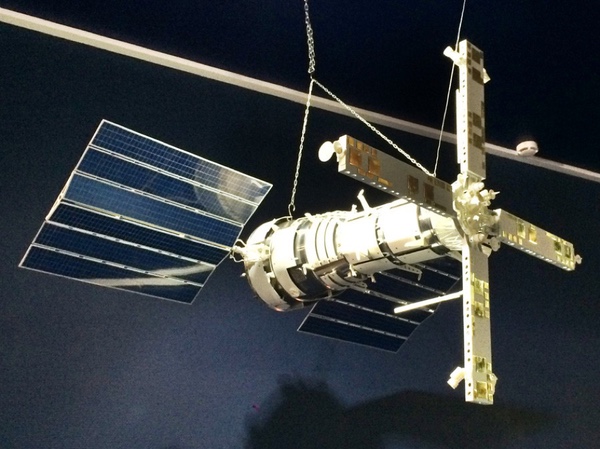The status of Russia’s signals intelligence satellitesby Bart Hendrickx
|
| Initiated shortly after the disintegration of the Soviet Union, the Liana project has suffered significant technical problems and delays over the years and has so far failed to live up to expectations. |
The Tselina satellites are believed to have observed both land-based and ocean-based targets, but that didn’t stop the Soviet Union from developing a separate ocean reconnaissance satellite system called Legenda that included two types of satellites. One was an electronic reconnaissance satellite named US-P(M) (flown from 1974 until 2006) and the other a nuclear-powered radar reconnaissance satellite designated US-A (flown from 1965 until 1988.) The primary task of these satellites was to accurately determine the positions of enemy ships in order to provide targeting data for anti-ship missiles carried by both ships and submarines.
Among the key players in these projects were the KB Yuzhnoye design bureau in Dnepropetrovsk, Ukraine (manufacturer of the Tselina satellites), the KB Arsenal design bureau in Leningrad/St.-Petersburg (manufacturer of the ocean reconnaissance satellites), and the Central Scientific Radiotechnical Research Institute or TsNIRTI (developer of the ELINT payloads) in Moscow.
In the 1980s, work got underway on a new-generation SIGINT system that would consist of two separate constellations, one for ELINT in orbits of 800 to 2,000 kilometers, and another for COMINT in geostationary orbit. The ELINT satellites (Tselina-3), to be developed jointly by KB Yuzhnoye and TsNIRTI, would carry out the same tasks as Tselina-2 and US-P. The geostationary COMINT satellites would be built by NPO PM (now ISS Reshetnev) and use the same bus as the company’s Luch data relay satellites. However, the collapse of the Soviet Union in late 1991 put an end to those plans. For the remainder of the decade and even beyond, Russia would have to content itself with occasional launches of US-PM and Tselina-2 satellites, the latter built by a design bureau that was now situated in independent Ukraine.[1]
Birth of the Liana project
The disintegration of the USSR plunged Russia into a deep economic crisis that left little room for initiating new space projects. Nevertheless, in 1993 the go-ahead was given for a new project that essentially combined the objectives of Tselina-3 and the Soviet radar ocean reconnaissance satellites. The project, named Liana (after the climbing and twining plants in tropical forests), officially started on August 9, 1993, when the Ministry of Defense awarded two separate contracts to TsNIRTI and KB Arsenal. TsNIRTI was named prime contractor and also given overall responsibility for the payloads and ground-based infrastructure. KB Arsenal was put in charge of developing the satellites and integrating them with the launch vehicle. The project leader was TsNIRTI’s Aleksandr A. Lebed, later replaced by Mikhail M. Krutov.
Preliminary design work conducted in 1994 determined the need to split Liana into two satellite constellations called Lotos and Pion (referring to the flower species “lotus” and “paeony”.) The two constellations and their associated ground-based infrastructure are also designated 14K159 and 14K160. Both types of satellites would use the same platform and carry passive ELINT systems, but Pion in addition to that would be equipped with an active radar system.
| Liana has been described in one TsNIRTI article as a system that operates in the interests of two “customers,” with Lotos and Pion carrying out partially overlapping functions. Those two end users are almost certainly the Russian Navy and the foreign intelligence branch of the Ministry of Defense. |
Original plans called for launching the two satellites with the Ukrainian-built Zenit rocket (another product of KB Yuzhnoye), but political exigencies necessitated a switch to the less powerful all-Russian Soyuz-2.1b launch vehicle in early 1997. This meant that the mass of Lotos had to be reduced from 9.4 tons to 7 tons and that of Pion from 10.5 tons to 7.2 tons, inevitably resulting in the loss of some operational capability. For instance, a low-frequency antenna had to be removed from Lotos and Pion became less accurate in determining the location of targets.
The redesigned satellites were supposed to begin test flights in 2004, but the project ran into serious delays, caused at least in part by the platform, which appears to have been designed from scratch. In order to speed up work, it was decided in 2002 to switch to a tried-and-tested satellite platform, namely the one earlier used by the Resurs-DK Earth remote sensing satellite of the Progress design bureau in Samara. This satellite in turn traced its roots to the first Soviet digital optical reconnaissance satellites. Despite the change of platform, the satellites remained compatible with the Soyuz-2.1b launch vehicle, also a product of the Progress design bureau. KB Arsenal and Progress signed a contract for the adaptation of the platform on April 24, 2002, but it looks like the design wasn’t frozen until 2006. The design lifetime for Lotos and Pion satellites was determined as five and four years respectively.
Liana has been described in one TsNIRTI article as a system that operates in the interests of two “customers,” with Lotos and Pion carrying out partially overlapping functions. Those two end users are almost certainly the same as those for Legenda and Tselina, namely the Russian Navy and the foreign intelligence branch of the Ministry of Defense. This is now called the Main Directorate of the General Staff of the Armed Forces (GU), but is still commonly known by its Soviet acronym GRU (Main Intelligence Directorate). One of the GU’s departments is believed to be responsible for space-based reconnaissance, performing more or less the same role as the US National Reconnaissance Office. The GU’s role in Liana is confirmed in a history of TsNIRTI published in 2008, which notes the institute’s close co-operation in Liana with both the Navy and what is called the “Center for Military and Technical Information” (TsVTI, its full name being 162 TsVTI). This is also known under several other names (Military Unit 54023, Center for Space Reconnaissance and Object T-500) and is the headquarters of the GU’s satellite intelligence department in Moscow.
It is not known how exactly functions are split between the two types of satellites, but indications are that Lotos was primarily conceived as a replacement for Tselina-2 (operating mainly for the GU), while Pion was supposed to combine the functions earlier performed by Legenda’s US-P and US-A satellites (mainly serving the needs of the Navy). However, there is unmistakable evidence that Lotos also performs SIGINT tasks in the interests of the Russian Navy. With Pion still grounded to the present day, that may actually be its primary function.[2]
Lotos and Pion design
The Resurs-DK type platform used by both Lotos and Pion, referred to in documentation as the “Support Module” (OM), is integrated with the payload at the Arsenal Machine Building Factory (MZ Arsenal) in St.-Petersburg, which is the production facility aligned with the KB Arsenal design bureau. Among the platform’s components are a hypergolic propulsion system (14D520) of KB Khimmash, control moment gyroscopes (14M527) of the Scientific Research Institute of Command Instruments (NII KP), and a satellite navigation system (14M829) of the Russian Institute of Radio Navigation and Time (RIRV).
Arsenal has built two versions of the Lotos satellites, an experimental version (with the military index 14F138) used only on the first mission, and an operational version (14F145) used on subsequent flights. Numerous sources claim the experimental version was called Lotos-S and the operational version Lotos-S1, but the latter name is not seen in official documentation. The 14F138 satellite was launched by the Soyuz-2.1a rocket, but the 14F145 version required the more powerful Soyuz-2.1b. Drawings released by KB Arsenal show that 14F145 has a larger payload section, consisting of two compartments rather than one.
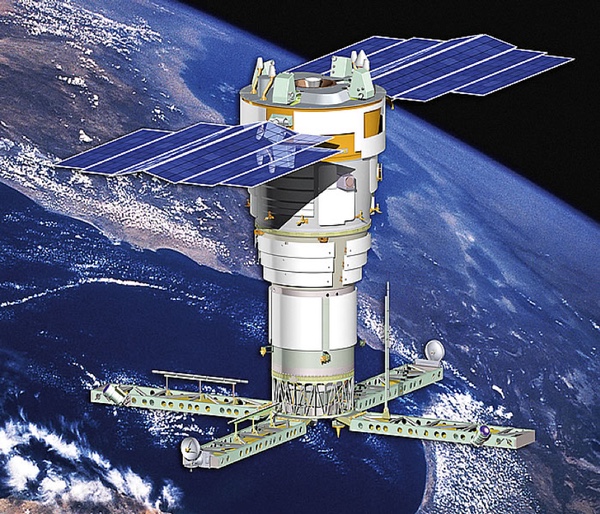 Drawings of 14F138 (above) and 14F145 (below). (credit: KB Arsenal) 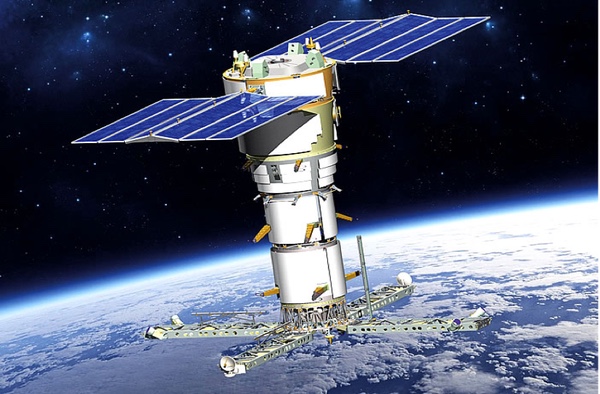 |
Lotos’ SIGINT payload is known as 14V120 or Bars-SM and was developed by TsNIRTI under the leadership of chief designer Yuri N. Kharitonov. Externally, it consists of four antennas that are mounted on the bottom of the payload section in a cross-shaped pattern. Because of limitations imposed by the design of Lotos (and probably also the launch vehicle’s payload shroud), the antennas are shorter than those carried by the Soviet satellites, but the TsNIRTI history published in 2008 said research was being done at the time “to miniaturize the antennas,” which would especially improve their ability to pick up signals with long wavelengths. These improvements were expected to be introduced in subsequent versions of the payload, indicating that its design has evolved over the years.
| The actual capabilities of Liana remain a closely guarded secret. Unverifiable Russian press reports claim Liana is 100 times more accurate than Legenda. |
According to TsNIRTI, Bars-SM has several improvements over the payloads flown in the Tselina and Legenda programs. It can detect a much wider range of frequencies, is much more sensitive, and makes it possible to determine the location of targets with greater accuracy. Unlike its predecessors, which sent data to the ground in raw form, Bars-SM’s on-board computer system can autonomously process information by turning the intercepted analog signals into digital form, after which it sends the processed data to end users in ready-to-use fashion. The increased use of digital systems reduced the size and mass of the payload by half, but did make the satellite more dependent on the supply of foreign-built electronic components, one TsNIRTI publication noted.
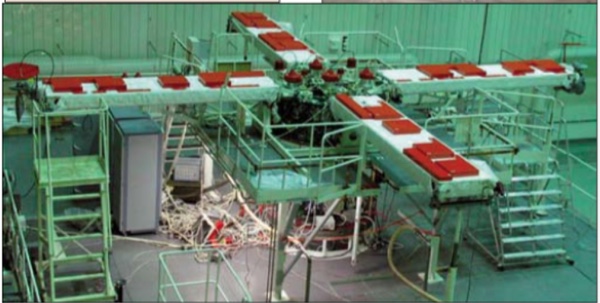 The antennas of Lotos’ Bars-SM payload undergoing ground tests. Source: TsNIRTI history published in 2008. |
Data are relayed to Earth using a system variously called 14R128, Trakon-MTs, and BAPI (On-Board Data Transmission Equipment), provided by the OKB MEI design bureau. The system can operate in four different channels (known as Traktat), one of which is intended to be used in conjunction with data relay satellites in geostationary orbit.
Pion (also called Pion-NKS and 14F139) has a more complex payload named 14V121 or Musson-LS. As prime contractor for Liana, TsNIRTI bears overall responsibility for Musson-LS, but it subcontracted virtually all of the work to other companies. Musson-LS consists of a payload called 14V228 and a synthetic aperture radar designated 11V521, both of which use the same data transmission system (14R128) as Lotos.
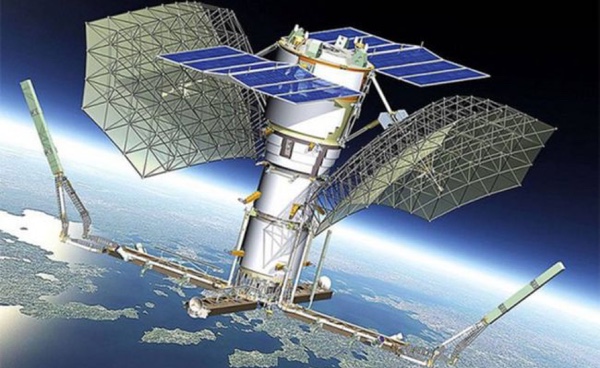 The Pion satellite. (credit: KB Arsenal) |
The 14V228 payload is produced by NII Vektor and its chief designer is Vladimir V. Yuferev. It is presumably what one source describes as “a passive channel to pick up broadband and narrowband signals,” using the four antennas seen on the bottom of the payload compartment. It can work in “time-sharing” fashion with the radar, suggesting the two systems can observe the same targets simultaneously. The payload presumably has very much the same function as the one flown on the Soviet electronic ocean reconnaissance satellites, determining the location and type of ships by picking up their radar transmissions. One PhD dissertation that can be linked to NII Vektor’s part of the Musson-LS payload indeed focuses on methods to analyze hard-to-detect radar signals.[3] However, NII Vektor also delivered the experimental COMINT payload for the Tselina-R satellites and, according to at least one source, lessons learned from Tselina-R were applied in the Liana program, a possible sign that 14V228 also has a limited capability to intercept voice communications.
The 11V521 radar system was built by the Vega Radio Engineering Corporation under the leadership of chief designers Igor G. Osipov, Vladimir E. Turuk and Andrei V. Yenyutin. Vega is no newcomer to the field, having already developed space-based radars for the Soviet Almaz-T vehicles (unmanned versions of the Almaz military space stations) and the more recent Kondor type radar observation satellites. The radar consists of two antennas mounted on either side of the satellite. The backbone structure of the antennas, made of an aluminum alloy, is supplied by the Scientific Center of Applied Electrodynamics (NTs PE). Each of the antennas has a diameter of 12.1 meters and a focal distance of 5 meters. Several papers and patents that can be linked to the antennas suggest their in-orbit deployment may be a relatively complex procedure.[4]
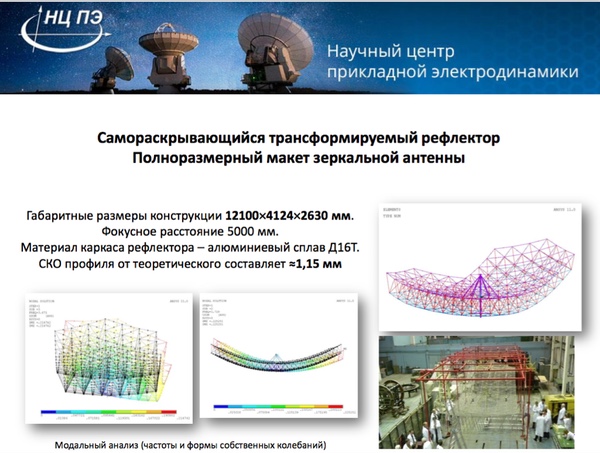 Slide showing elements of Pion’s radar antenna. (credit: NTs PE) |
The radar system assists the passive ELINT systems in determining the location and type of sea-going vessels. The images it takes may not be detailed enough to readily identify the observed vessels. A patent co-authored by two of the radar’s chief designers describes a complex method to identify ships by comparing satellite radar images with three-dimensional computer models of known types of ships compiled on the basis of other radar imagery, photographs and drawings.[5] In 2013, KB Arsenal proposed a somewhat downsized civilian version of Pion called Fikus with what appears to be exactly the same radar system. Performance data for the radar given at the time should be very similar to those of Pion, although it is not known if Pion will be placed into exactly the same orbit.
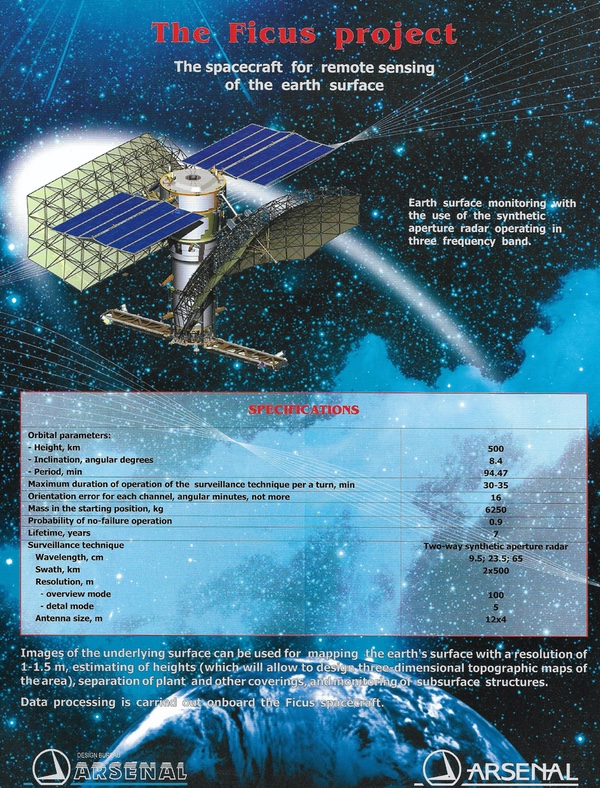 Proposed Fikus satellite based on Pion. The inclination is wrongly given as 8.4° instead of 81.4°. Source: KB Arsenal brochure disseminated at the MAKS 2013 aerospace show. |
The actual capabilities of Liana remain a closely guarded secret. Unverifiable Russian press reports claim Liana is 100 times more accurate than Legenda, having the ability to determine the location of both land-based and ocean-based objects as small as one meter with an accuracy of three meters. One Russian Navy journal recently summed up the capabilities that a modern space-based ocean reconnaissance system should possess (without saying Liana actually has them.) Aside from providing targeting data for anti-ship missiles, it should also carry out pure reconnaissance tasks such as regular monitoring of the composition and distribution of enemy naval formations, surveillance of naval bases, observations of hydrometeorological conditions in which naval formations operate, as well as early warning of possible attacks launched from the seas and oceans.[6]
Notably absent from the reported targets are submarines. One Russian press article quoting a source within the Ministry of Defense did claim that Liana satellites would pick up and relay signals from sonars installed near the country’s coastlines with the specific goal of detecting enemy submarines.[7] However, there are no indications that the satellites themselves can detect submarines. One Russian experimental military satellite (Kanopus-ST/14F147) that seems to have been intended primarily to spot submarines failed to separate from its launch vehicle’s upper stage in December 2015 and re-entered shortly afterwards.[8]
Liana’s ground segment
Satellites flown under the Liana program are controlled from the Titov Space Control Center in Krasnoznamensk near Moscow, which also serves as a mission control center for most other Russian military satellites. However, there seem to be two separate networks to receive and process the information sent down to Earth in the interests of the GU and the Navy. These appear to be upgraded versions of infrastructure developed in the Soviet days for Tselina and Legenda.
| One Russian experimental military satellite (Kanopus-ST/14F147) that seems to have been intended primarily to spot submarines failed to separate from its launch vehicle’s upper stage in December 2015 and re-entered shortly afterwards. |
The Tselina-2 satellites relied on two data reception centers (named Krona and Baikal) that in turn relayed the obtained information to a data processing center. The ground-based network was significantly upgraded in 2003, mainly by replacing bulky computer systems with smaller IBM personal computers. Some TsNIRTI publications refer to Liana’s data reception centers as Trapetsiya-KS. According to one source, Trapetsiya-2KS was originally planned to be used by the canceled Tselina-3 satellites and an experimental version (Trapetsiya-S2LE) was already tested by Tselina-2. Among the hardware used by Trapetsiya-KS is a 2.4-meter antenna (TNA-2.4S), which according to its manufacturer (NPP ATS) is designed to work with geostationary relay satellites (for both downlink and uplink of information).[9]
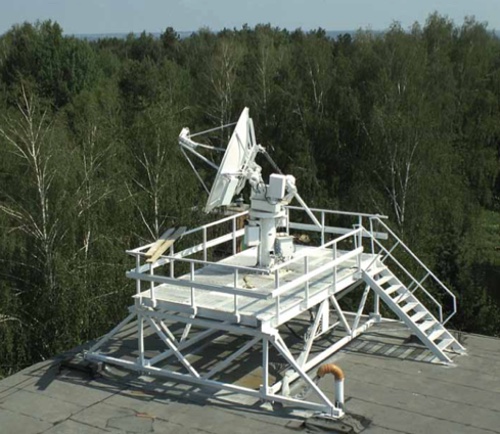 The TNA-2.4S antenna used to communicate with Liana satellites. (Source) |
The Soviet Navy had ground facilities for Legenda some 60 kilometers east of Moscow in a small military town called Noginsk-9 or Dubrovo, which is also home to the headquarters of the country’s space surveillance network. This infrastructure was co-located with that used for the Soviet co-orbital anti-satellite system named IS (“Satellite Destroyer”) and has been variously referred to as the 2nd Central Naval Observatory, Object 224Sh, Military Unit 72175 and the Navy’s 69th Test Center. In the Soviet days, it consisted of a mission control center, a data reception and processing center, and a complex of five antennas that used interferometry techniques to accurately determine the satellites’ orbital parameters. With the present-day satellites relying on on-board satellite navigation equipment, these antennas have since been dismantled, but at least two sources make it possible to determine that the center is still operational and has some kind of role in Liana.[10] It is likely used for data reception, but may have control tasks as well.
There is also equipment installed on several types of surface ships and submarines that can receive targeting data directly from the satellites. In the Soviet era this equipment (with code names such as 3KR, 5KR, 10K, and 12KR) was built by the Ukrainian design bureau NII Kvant and a handful of documents indicate that at least some of it continued to be delivered until well after the turn of the century under a Russian-Ukrainian agreement on military cooperation signed in 1993.
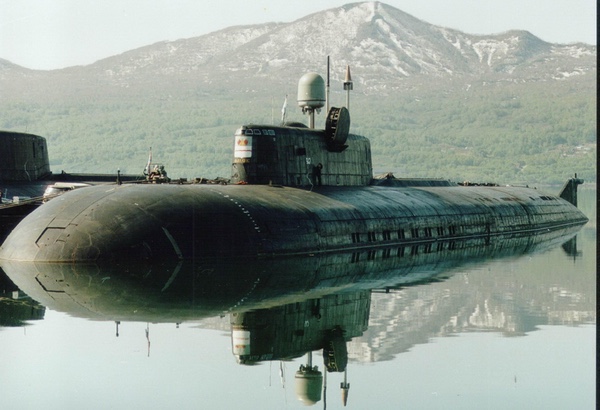 Soviet Project 949 submarine with a satellite receiving antenna that got the Western nickname “Punch Bowl”. (Source) |
Whereas the Soviet satellite receiving equipment needed to turn the raw satellite data into usable targeting information, the data sent back by the Liana satellites should be ready to use thanks to their on-board processing capability. Available sources presumably give only a fragmented view of the systems currently used. At least one of the Soviet systems, 3KR (also known as Korall-B2), was modified for Liana by the Russian company AO Zaslon (formerly Zavod Leninets) under the names 3KR-01 and Korall-B2L.[11] It is installed on Project 949A/Antei nuclear-powered submarines developed by the Rubin design bureau and operated by Russia’s Northern and Pacific Fleets. The submarines are armed with P-700/Granit anti-ship cruise missiles and have been in operation since the 1980s. They are being modified under Project 949AM to carry more capable P-800/Oniks and 3M54/Kalibr missiles. The first tests of 3KR-01 may have been carried out in 2014. Press reports in September of that year said the first modernized targeting system to be used in conjunction with Liana had completed testing on a Northern Fleet submarine. The system was not mentioned by name, but was linked to both Rubin and Zavod Leninets.[12]
A new system called 3Ts-30 was developed by Granit-Elektron for installation on Project 885M/Yasen and Project 636/Varshavyanka type submarines as well as a number of surface vessels.[13] The new-generation Yasen nuclear submarines, currently used only by the Northern Fleet, are slated to replace the Russian Navy’s current Soviet-era nuclear attack submarines and are equipped with Oniks, Kalibr, and 3M22/Tsirkon missiles. The latter are maneuvering hypersonic cruise missiles with a maximum range of 750–1,000 kilometers and maximum speed of Mach 8 that are extremely difficult to detect and intercept. The diesel-powered Project 636/Varshavyanka submarines were introduced in the 1990s and carry Kalibr missiles. Among the surface vessels being equipped with the 3Ts-30 system are Project 21631/Buyan type corvettes, also armed with the Kalibr missiles. According to one Granit-Elektron article, the 3Ts-30 system can receive targeting information from both satellites and aircraft.[14]
Granit-Elektron has also produced radar systems known as 5P-20K and 5P-20KA that have one channel to receive information from orbiting satellites. One document confirms that the 5P-20K system is compatible with both Lotos and Pion. The system should be installed on Project 20380/Steregushchiy corvettes and Project 22350/Admiral Gorshkov class frigates, all of which can carry Kalibr, Oniks, and Tsirkon missiles.[15]
Liana launch history and status
In the middle of 2009, almost sixteen years after the official start of the Liana project, MZ Arsenal in St.-Petersburg finally finished the assembly of the experimental Lotos satellite 14F138 (serial number 801). However, shortly after it reached the launch pad atop its Soyuz-2.1a launch vehicle at the Plesetsk cosmodrome, a fault was discovered in the payload that forced it to be shipped back to the manufacturer. In the end, the satellite was launched as Kosmos-2455 on November 20, 2009, ending up in a roughly 900-kilometer circular orbit inclined 67.2 degrees to the equator. The mission immediately ran into trouble when one of the four SIGINT antennas failed to deploy, but the problem was fixed about a week after launch. TsNIRTI claims the satellite operated for five years and two months rather than the expected three years, acknowledging only that it experienced “some flaws.” Industry sources talking to the newspaper Izvestiya painted a different picture, claiming that soon after launch almost half of the satellite’s on-board systems failed, mainly due to software issues.
| The first 14F145 satellite went up on a Soyuz-2.1b rocket as Kosmos-2502 on December 25, 2014, but that mission also appears to have been far from an unqualified success. |
Despite the seemingly trouble-plagued maiden flight of Lotos, work went ahead on building the first operational version of the satellite (14F145/serial number 802). This had an increased design lifetime (five rather than three years) and updated software to increase its resolving power and expand the range of frequencies it could intercept (including what are called “narrowband signals”.) It also carried hardened electronics to better protect it against the effects of space radiation, a possible sign that this had played a major role in the software glitches reportedly experienced by Kosmos-2455. According to one TsNIRTI article, this measure was required not only as a result of the first Lotos mission, but also that of the first Persona optical reconnaissance satellite (Kosmos-2441), which is known to have failed shortly after launch in 2008 due to radiation effects on some of its electronic systems.
The first 14F145 satellite went up on a Soyuz-2.1b rocket as Kosmos-2502 on December 25, 2014, but that mission also appears to have been far from an unqualified success. Court documentation reveals that sometime before the summer of 2016, the satellite suffered “an irreparable failure” in its data transmission system which “impeded its normal functioning.” This led to further delays in the program, with the first of three follow-on satellites ordered in 2014 (serial numbers 803 to 805) not going up until December 2, 2017 (Kosmos-2524). The other two were placed into orbit on October 25, 2018 (Kosmos-2528) and February 2, 2021 (Kosmos-2549) and US satellite tracking data indicate that only these two are currently operational. A batch of four more Lotos satellites (serial numbers 806 to 809) is known to have been ordered in 2017 and these should be launched in the coming years.[16]
As for Pion, the only satellite known to have been built (14F139 serial nr. 901) has been struggling to get off the ground for many years. The exact cause of the delays is not known, but since Pion uses a bus that is virtually identical to that of Lotos, it is safe to assume that the main culprit has been the payload. The lengthy delays suffered by Pion have clearly been a thorn in the side of Russian Defense Minister Sergei Shoigu, who in recent years has held several meetings on the matter that were openly reported in the Russian press. In March 2020, Shoigu declared that work on the satellite was nearing completion, but procurement documentation released somewhat later showed that the satellite’s radar was still supposed to undergo environmental testing at NPO Mashinostroyeniya in Moscow during the summer before it could be shipped to St.-Petersburg for integration with the bus.[17] However, there are some signs that Pion will finally be launched later this year.
Russian press articles have stated that a fully operational Liana constellation should consist of at least two Lotos and two Pion satellites, but there is no sign in openly available documentation of work on a second Pion satellite, raising the question if it even exists.
The current amount of satellites is not sufficient to provide full-time coverage of critical areas and furnish accurate targeting data, especially for constantly moving naval targets. The use of long-range missiles such as Tsirkon places even higher demands on the accuracy of those data. An additional problem is that Russia currently has only one operational military data relay satellite (launched in 2015), which severely limits the Liana constellation’s ability to send back data in real time.
| Even the Russian Navy’s official monthly magazine recently acknowledged the “negative state of affairs” in Russia’s space-based ocean surveillance program. |
If the four remaining Lotos satellites can be launched with sufficiently short intervals, they should give Russia a significant space-based ELINT capability, but the radar-equipped Pion satellites undoubtedly are an absolutely vital element to support Navy operations. For instance, as one analyst recently noted, only they would be capable of spotting naval targets that maintain radio silence.[18]
In short, it is quite clear that the Liana program has so far failed to live up to expectations, certainly when it comes to observations in the interests of the Navy. Last summer, an authoritative Russian magazine covering the country’s military industry lamented Liana’s slow progress and the Kremlin’s apparent lack of interest in giving it appropriate funding. The delays experienced by Liana cannot be compensated by reconnaissance ships and ocean reconnaissance aircraft. According to the article, their numbers are also insufficient to obtain accurate targeting information for missiles such as Tsirkon, Kalibr, and Kinzhal, a much-hyped air-launched missile designed to attack both fixed and mobile targets such as aircraft carriers.[19] Even the Russian Navy’s official monthly magazine recently acknowledged the “negative state of affairs” in Russia’s space-based ocean surveillance program.[20]
Akvarel
In January 2013, the Izvestiya newspaper revealed plans for a new satellite constellation called Akvarel (meaning “watercolor”) that according to its sources would become “the most grandiose reconnaissance system in Russia’s history.” The article was vague about its objectives, saying that initially it would be used in the interests of the Navy and, unlike Liana, would be able to send data to ships and air bases in near real-time. Also part of the system would be at least five “[data] reception and transmission centers” spread over the entire territory of the Russian Federation. These would serve as “a sort of motherboard to which future systems and radar, optical reconnaissance and signals intelligence satellites can hook up,” as the newspaper literally put it. According to Izvestiya, a secret tender to develop “the basis of the system” had been announced in late 2012 and won by TsNIRTI, which had beaten five other bidders. Work was expected to begin that summer.[21]
Nothing more was heard of Akvarel until the name resurfaced in court documentation published in early 2016. This revealed that the role of prime contractor for Akvarel had been assigned to ISS Reshetnev, best known as a manufacturer of communications and navigation satellites. The company had received a contract for Akvarel from the Ministry of Defense on April 28, 2014, and had subsequently subcontracted work on the payload to TsNIRTI on August 1, 2014. Akvarel was described only as a “low-orbiting SIGINT system,” indicating it is not as broad in scope as the Izvestiya article had suggested and is probably only a successor to Liana.[22] On the same day that ISS Reshetnev was awarded the Akvarel contract, it also received a contract for another military satellite system called Gerakl (“Hercules”), possibly a new-generation military data relay satellite. The timing may have been coincidental, but could just as well point to a connection between the two projects. Gerakl could conceivably play a crucial role in ensuring that data is transmitted to end users in near real-time.
Virtually nothing has leaked out on Akvarel since, except for some information on various subsystems. In an article published in 2017, TsNIRTI acknowledged that it was involved in what it called a sixth-generation SIGINT satellite system, most likely Akvarel.[23] The project’s current status is unknown.
Repei
ISS Reshetnev is also the prime contractor for what appears to be another SIGINT satellite constellation called Repei (a word denoting a variety of plant species). The existence of this project became known by sheer accident when photographs were released in June 2017 of a visit by Defense Minister Sergei Shoigu to ISS Reshetnev. In one of the pictures, Shoigu was seen looking at a board with information on satellites called Repei-S and Repei-V as well as a drawing of one of the two. It could also be learned from this that Repei-S was a geostationary satellite and Repei-V was intended to operate in highly elliptical orbits.[24]
 Defense Minister Sergei Shoigu is shown a board containing information on Repei-S and Repei-V. (Source) 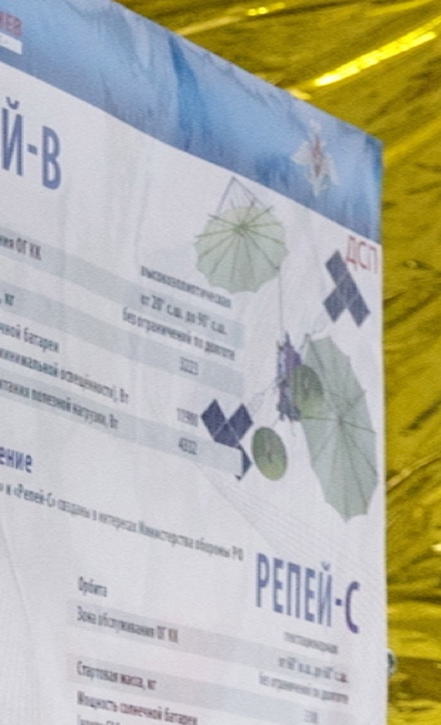 |
Some more information on the project emerged in the following years, mainly through procurement and court documentation. The project officially started on September 1, 2014, with a contract awarded to ISS Reshetnev by the Ministry of Defense. The overall program has the designator 14K048 and is also referred to in some documentation as Project 777. The code names 14K178 and 14K179 are used for the two separate constellations and 14F158 and 14F159 for the individual satellites.
| All things considered, Russia’s space-based SIGINT effort is lagging far behind that of the United States and China. |
In November 2017, the Izvestiya newspaper identified Repei as a signals intelligence satellite, saying it would be able, among other things, to detect radars, radio emissions, and telemetry from rocket launches. The newspaper didn’t disclose its source for that information, saying only that ISS Reshetnev officials had declined to answer questions about the project.[25] However, a satellite looking very similar to the one seen on the board was identified as a SIGINT satellite in a presentation given by ISS Reshetnev in early 2019.[26] One other piece of evidence pointing to a SIGINT role for Repei comes from a document describing a test stand at Tomsk State University to simulate the functioning of the satellites’ payload and its interaction with ground-based systems. This makes it clear that the payload is designed to intercept what are called “radio emission sources” and turn them into digital signals that are subsequently sent to Earth for processing, among other things to determine the position of the radio sources.[27]
The term “radio emission source” can, in principle, refer to anything in the radio part of the electromagnetic spectrum, but there is good reason to believe that Repei will be largely dedicated to communications intelligence. First, the geostationary and highly elliptical orbits that will be used by these satellites are perfectly suited for COMINT and have also been employed by similar American satellites. Unlike low-orbiting satellites, which have a slim chance of picking up interesting voice communications during their relatively brief passes over any given area, satellites in these high orbits can keep an almost constant eye on regions of interest. The Repei-V satellites will likely be placed into highly elliptical Molniya-type orbits with apogees high above the northern hemisphere, allowing them to eavesdrop on radio emission sources situated at high latitudes that cannot be seen by the geostationary Repei-S satellites.
Second, Repei seems to have evolved from plans back in the 1980s to entrust ISS Reshetnev (then called NPO PM) with the development of geostationary COMINT satellites, which were supposed to complement the Tselina-3 ELINT satellites in low orbits. As mentioned earlier, the collapse of the USSR forced these plans to be shelved, but NPO PM’s COMINT project seems to have been resurrected in 1992 under the name Labirint (also known as 14K034). Like Repei, this envisaged the deployment of satellites in highly elliptical and geostationary orbits—Labirint-V (14F141) and Labirint-S (14F144)—with a payload called 14R513. Amazingly, this project dragged on for more than 20 years before it was finally canceled. Court documents show that it began on May 25, 1992, and was terminated in early 2014, with Labirint-S apparently having been scrapped at an earlier stage. In February 2014, Russia’s Minister of Defense sent a letter to President Putin, recommending him to end Labirint and start a replacement project, which then apparently became Repei, initiated in September 2014.[28]
Little can be learned about Repei’s design from available documentation except that it carries KM-75 Hall effect ion thrusters of the Keldysh Research Center and is equipped with a so-called “Small On-Board Complex for Analysis of Interference” (MBKAP), a system that is presumably needed to protect the satellite from jamming. Ground tests of this system are taking place this year for one 14F158 and one 14F159 satellite, indicating that at least one Repei-V and one Repei-S are currently under construction and may be launched in the not too distant future.[29] Both Repei-V and Repei-S will most likely be launched by Angara-A5 rockets from Plesetsk.
Yet another type of satellite produced by ISS Reshetnev may be intended to intercept signals uplinked to and/or downlinked from foreign communications satellites in geostationary orbit. Publicly known as Olimp-K/Luch, the first of these was launched by a Proton rocket from Baikonur on September 28, 2014. For the past six and a half years, the satellite has been traveling across the geostationary belt and has parked near more than a dozen commercial communications satellites for periods ranging from several weeks to several months. It could be the Russian equivalent of two top-secret American signals intelligence satellites launched in 2009 and 2014 and variously referred to as PAN, CLIO, and Nemesis. A second Olimp-K satellite is due for launch this year or next.
All things considered, Russia’s space-based SIGINT effort is lagging far behind that of the United States and China. Long delays in the Liana program are severely impacting Russia’s ability to collect accurate targeting data for its latest generation of anti-ship missiles and a replacement system (Akvarel) is likely still many years away from deployment. The Liana system does not appear to have a significant (if any) COMINT capability, a situation that will not be rectified until the first Repei satellites are launched in the coming years. In addition to that, Russia is relying on a pair of aging satellites for optical reconnaissance and currently does not have any radar reconnaissance satellites in orbit that can see through cloud cover and make nighttime observations.[30] All this leaves the country’s present space-based intelligence gathering capability in a state that leaves much to be desired.
References
- For comprehensive English-language histories of Soviet signals intelligence and ocean reconnaissance satellites, see: B. Hendrickx, Snooping on Radars: A History of Soviet/Russian Global Signals Intelligence Satellites , Space Chronicle, 2005, Suppl. 2 ; A. Siddiqi, Staring at the Sea: The Soviet RORSAT and EORSAT Programmes , Journal of the British Interplanetary Society, November/December 1999.
- Main sources of information on Liana’s history: B.S. Lobanov (ed.), “TsNIRTI 65 let”, Moscow: TsNIRTI, 2008, pp. 50–88 ; A.I. Zotov et al, “Development of satellites by FGUP TsNIRTI Named After A.I. Berg in 1992-2015” (in Russian), published in: Istoriya razvitiya otechestvennykh avtomaticheskikh kosmicheskikh apparatov, Moscow: Stolichnaya Entsiklopediya, 2015, pp. 568-573.
- Summary of PhD dissertation (in Russian) published in 2015. The author refers to Musson-LS as “M-LS”.
- Articles (in Russian) published in 2009 and 2017 (pp. 22-26) ; Patents (in Russian) published in 2013 (1, 2).
- Patent (in Russian) published in 2011.
- Article (in Russian) published in “Morskoi sbornik”, 2/2021, pp. 56–61.
- Article (in Russian) published in “Svobodnaya pressa”, January 13, 2017.
- Main sources of information on Lotos and Pion design features: B.S. Lobanov, op. cit. ; A.I. Zotov, op. cit. ; Articles (in Russian) published by TsNIRTI in “Vozdushno-kosmicheskiy rubezh”, November 2017 (pp. 14-23), February 2019 (pp. 23-27) ; Court documentation (in Russian) published in 2018–2019.
- TsNIRTI article in “Vozdushno-kosmicheskiy rubezh”, November 2017 (see reference 8) ; History (in Russian) of the OKB MEI design bureau, 2015, p. 64. ; Website of NPP ATS.
- Interview (in Russian) with the commander of the Navy’s 69th Test Center Ruslan Korchevskiy ; Procurement documentation (in Russian) published in 2014.
- Procurement documentation (in Russian) published in September 2015, September 2016, and April 2018.
- RIA report (in Russian), September 2, 2014.
- Article in “Morskoi sbornik”, 2/2021 (see reference 6).
- Article (in Russian) published in “OPK RF”, August 2017, pp. 56–57.
- Court documentation (in Russian) published in 2015 ; Article (in Russian) by Granit-Elektron published in 2017.
- Main sources of information on Lotos missions: A.I. Zotov, op. cit. ; Article (in Russian) published in “Izvestiya”, September 27, 2012 ; TsNIRTI article in “Vozdushno-kosmicheskiy rubezh”, November 2017 (see reference 8) ; Court documentation (in Russian) published in 2018–2019.
- Procurement documentation (in Russian) published in May 2020.
- Article (in Russian) published in “Svobodnaya pressa”, March 15, 2021.
- Article (in Russian) published in “Voyenno-promyshlennyy kuryer”, August 18, 2020.
- Article in “Morskoi sbornik”, 2/2021 (see reference 6).
- Article (in Russian) published in “Izvestiya”, January 22, 2013.
- Court documentation (in Russian) published in March 2016.
- TsNIRTI article in “Vozdushno-kosmicheskiy rubezh”, November 2017 (see reference 8).
- Russia may have accidentally revealed its new military satellites, Jane’s Intelligence Review, June 22, 2017.
- Article (in Russian) published in “Izvestiya”, November 13, 2017.
- Presentation (in Russian) given by ISS Reshetnev general director N. Testoyedov in February 2019, p. 14.
- Document describing research project “APK-Stend” of Tomsk State University (no longer available online).
- Court documentation (in Russian) published in 2018-2019.
- Website of the Scientific Technological Center ‘Space Instrument Building’ (NTTs KP).
- B. Hendrickx, Upgrading Russia’s fleet of optical reconnaissance satellites, The Space Review, August 10, 2020.
Note: we are using a new commenting system, which may require you to create a new account.
